
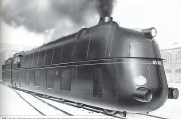
| WAS GERMAN 05 002 THE WORLD'S FASTEST STEAM LOCO? | ||
 | 
| |
| Last updated 6 March 2021: Web page re-formatted and uploaded again to the Internet
| ||
| Index | ||
| Introduction | An overview of what this part of the web site will cover | |
| 05 002
|
A remarkable loco that produced an astounding set of high speed runs in 1935/36
| |
| 05 002 v Mallard
|
Which of these two locos was the fastest?
Includes High Speed 05 Test Manager Paul Roth's account | |
| Milwaukee Road | Milkwaukee's streamlined "Hiawatha" A class Atlantics and F7 Hudsons | |
| Other Fast USA locos | This section not yet available | |
| 18 201 | Currently the World's Fastest Operational Steam Locomotive | |
| Help Needed | Help needed to progress my research on high speed steam running | |
|
|
| Deutsche Reichsbahn 4-6-4 Baureihe 05, (excluding cabforward 05 003) | ||||
| Built | Borsig 1935 | Total weight incl tender | 212 tonnes | |
| Number Built | 2 locos Nos 05 001-2 | Fuel | Coal | |
| Withdrawn | Rebuilt 1950, Withdrawn 1958, 05 001 preserved | Fire grate area | 50.5 sq ft | |
| Cylinders | 3, 18" x 26" | Max i.hp | More than 3,400 | |
| Driving Wheels | 90.6" diameter | Boiler Pressure | 290 psi
| |
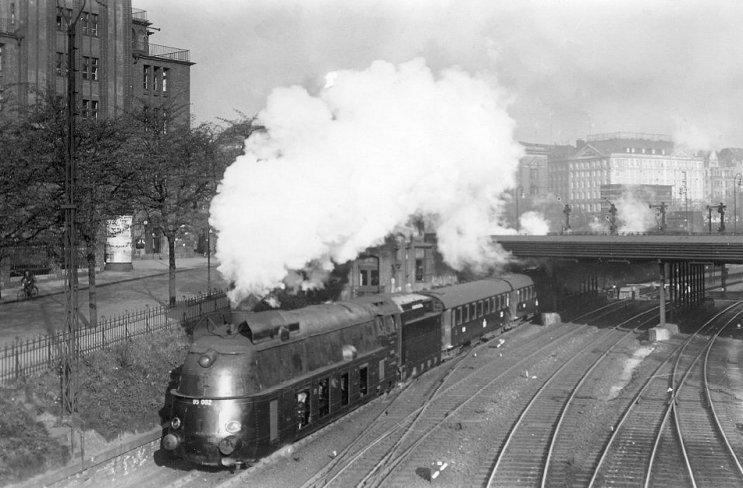
05 002 leaving Hamburg Hbf on train FD23 for Berlin in 1938. Photo Carl Bellingrodt, from the Joachim Buegel Collection. |
|
1935 built Borsig streamlined 4-6-4 Hudson 05 002 was one of two locos designed for high speed tests, (mainly done by 05 002), and a Berlin-Hamburg service. Despite it's record achievements it was scrapped: sister loco 05 001 was retained for the German Railway Museum at Nürnberg. Research is still underway about 05 001 and 05 002, but in advance of that being posted here, the table below gives a good reasons why 05 002 is considered for the title "The World's Fastest Steam Locomotive". Authentic records of so many very fast runs exist for no other steam locomotive anywhere. Nine times over 110 mph, five times over 115 mph and twice over 120 mph! And very many miles at over 100 mph. Plus the start to stop average speed world record for steam, despite being eased down at the end of that run! All from Dynamometer car records. |
| 05 002: A very fast German steam locomotive | |||||
|---|---|---|---|---|---|
| All details originate from Messwagen, (Dynamometer), car readings | |||||
| Date | Max Speed | Train | Location where maximum speed | Route | |
| Km/h | Mph | weight | was reached | ||
| 07 June 1935 | 191.7 | 119.1 | 196t | Paulienaue-Nauen | Hamburg to Berlin |
| 23 July 1935 | 187 | 116 | 241t | Berlin-Hamburg-Berlin | |
| 26 July 1935 | 195.7 | 121.6 | 205t | Near Bergerdamm | Hamburg to Berlin |
| 18 October 1935 | 177.3 | 110.2 | 254t | Berlin to Hamburg | |
| 5 February 1936 | 180 | 112 | 242t | Approaching Ludwigslust | Berlin-Hamburg |
| 5 February 1936 | 180 | 112 | 242t | Approaching Hagenow | Berlin-Hamburg |
| 11 May 1936 | 178.2 | 110.7 | 197t | Just before Wittenberge stop | Hamburg to Berlin |
| 11 May 1936 | 200.4 | 124.5 | 197t | Friesack (Mark) | Hamburg to Berlin |
| 30 May 1936 | 190 | 118 | 145t | Approaching Ludwigslust | Berlin to Hamburg |
| 30 May 1936 | 166.5 | 103.5 | 145t | Wittenberge - Km 13.9, 70.1 miles in 48 mins 32 secs start to stop. 86.66 mph start to stop average. World record for steam | Hamburg to Berlin |
|
Gradient Profile The outline gradient profile and dynamometer car speed trace shown above have been re-created by reference to copies of the original documents published in Alfred B. Gottwaldt's "Baureihe 05 - Schnellste Dampflok der Welt". Robin Garn has helped with the gradient details from a 1920's profile. That profile shows a short uphill section at 1/300 just before the main 1/1000 stretch plus a few more very minor fluctuations, although for this purpose the short 1/300 climb has been left out as it is not clearly shown on the 1936 profile. Additionally it is not know whether the main 1/1000 was downhill or uphill! It is of interest here that on the May 30th 1936 run which CJ Allen later published, and in the opposite direction to it's record run, 05002 on an undemanding schedule and a light load, sustained 97 mph throughout with less than 2/3rds throttle and 20% cut off. The stretch over which 05 002 accelerated from just under 123 mph to 124.5 mph was on a grade very close to level track. So it is clear that 05 002 did not have significant downhill help in the final stages of it's acceleration. Indeed it also had to climb a 2.5 mile up grade at 1/666 in the build up to it's maximum after it had passed 103 mph, where speed mainly rose to nearly 106 mph. Dynamometer Car Speed Trace The small copy of the dynamometer car trace that has been published must be a copy of the original, and shows 05 002 accelerated at a fairly steady rate from just over 100 mph to around 115 mph without significant speed fluctuations. From around 115 mph to 124.5 mph acceleration was again at a fairly steady rate, (but slightly slower than from 100 mph to 115 mph). Very close examination of a much larger high resolution temporary copy of the speed trace shows that the speed line clearly crosses the 200 km/h line, (124.3 mph), for more than just a momentary distance. From this examination there is no doubt at all that the maximum of 200.4 km/h, (124.5 mph), is a fair record of what was recorded in the dynamometer car on 11th May 1936. Indeed my examination indicates the German Railway Engineers could have been conservative in their assessment of the maximum. This close up examination also confirms that the loco was running at, or above 200 km/h, (124.3 mph), for a good distance, although maybe not quite as long as the 3 kilometres, (nearly 2 miles), mentioned in Gottwaldt's book. |
|
Horsepower Outputs
On the right is the dynamometer car drawbar horsepower trace, (green line), indicating the loco controls were changed several times as speed rose. 05 002 was worked hard to around 110 mph, when it was eased a little on the slight downgrade, with dbhp dropping to around 1,700. As the grade eased the loco was opened up before the near level section. As is correct with a steam loco, at the maximum speed the horsepower of just under 2000 dbhp was not as high as the peak, which would normally be reached well below 100 mph. The apparent "easing" of the loco on the slight descent before the near level section begs the question as to what could have been achieved with unchanged loco controls. Time and speed details. The data currently available for 05 002's run does not provide the detailed times and dynamometer car speeds at individual kilometre posts and other passing points like stations. If precise dynamometer car speed details for each km post were available it would be a simple matter with a computer to convert these speeds to exact times over short/medium distances, and then compare these with the actual times recorded. That would provide a check on the speeds recorded by the dynamometer car. Efforts will be made to see if this source data is available. CJ Allen makes no comment on any problems with the dynamometer car accuracy during his 30th May 118 mph run. Further analysis of the 11th May data will be done if the original documentation can be found. |
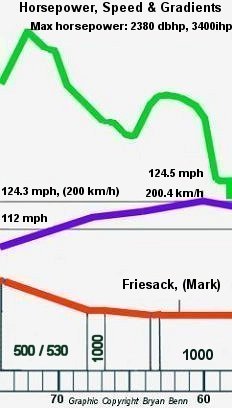 Content subject to the limitations of the screen display and the software used.
Content subject to the limitations of the screen display and the software used. |
|
Summary of Notes
There is nothing above that detracts from 05 002 having reached 200.4 km/h, 124.5 mph on 11th May 1936. Is it realistic to make the same statement about Mallard? Read on! But before that, an eyewitness footplate report of 05 002's run. | |
|
05 002 v Mallard. Paul Roth's Account of 05 002's run
Thanks to Torsten Sohns who has prepared this translation, we can read an account from Paul Roth, the Manager responsible for the 05 high speed test programme in the 1930s. The report gives background information and ends with a dramatic eyewitness account of the record run on 11th May 1936, when Paul Roth was on the footplate of 05 002. "According to the usual procedures for new locomotive types, the locos 05 001 and 05 002 first came to the Locomotive Testing Office Grunewald for thorough evaluation. The Testing Office was quite happy with orders coming from the Reichsbahn Central Office as well as from the previous Reichsbahn Administration requiring repeatedly to challenge the class 05 to the utmost possible tests in terms of speed under load....Probably the chief engineer Dr. Wagner and also the construction teams in (Berlin-)Tegel had secretly envisioned breaking the 200 km/h barrier in all their planning. However this aim was not easy to achieve. As a consequence of their overdevelopment, the acceleration of the class 05 was unsatisfactory. ... For a long time, 195 km/h was a barrier we could not overcome...... (During numerous high speed tests in spring 1936 problems came up such as broken joint bolts, burst springs and tires, discouraging the testing engineers)..." "At least we were no longer pushed from above for going up to 200 km/h. With sustained 195 km/h running (121 mph) the class 05 was anyway the fastest loco of the world..... But life is as it is: The 200 km/h barrier was eventually passed almost incidentally and without any profound preparations. In May 1936 once again presentation excursions took place. To this end for round trips Berlin - Hannover - Bremen - Hamburg several high speed railcars and the Henschel-Wegmann streamline steam train were committed and on the final segment Hamburg - Berlin the 05 002 with dynamometer car and 4 most recent coaches was employed. Since one of these coaches had got a bearing problem on the previous day, on 11 May 1936 the 05 002 hauled only 4 coaches making 200 tons instead of the usual regular weight of 250 tons....." "According to the schedule we should have had a non-stop ride from Hamburg to Berlin Lehrter Bahnhof. At the scheduled speed of 180 km/h (112 mph) over a distance of 290 km (180 miles). Anyway everything was expected to run well, so there were no plans to exceed this speed. However the train was stopped unexpectedly before we reached Wittenberge. This provided an opportunity not only to check the temperature of all axle and rod bearings but also to lubricate the sensitive rod bearings. The weather on this day was moist and dull. Therefore, all bearings had performed well. Moreover, the wet soil absorbed the dust. Consequently, this could not do any harm to the bearings either...." "Having started again, the train ran through some speed limited sections where it could make not more than 140 - 150 km/h (87 - 93 mph). In order to regain lost time from the stop in Wittenberge the speed had to exceed 180 km/h (112 mph) on the remaining distance to Berlin. Even now no one thought of 200 km/h. It was necessary, anyway, to bring out the best in the engine in order to achieve 190 km/h (118 mph). However, now it turned out that as a result of the reduction of train weight by 50 tons, the missing wind from the side on this day and due to the wet rails the train resistance was significantly reduced and the 05 reached 195 km/h much faster than usual. At this speed a howling at the chimney started which we knew well. It sounded similar to a ship hooter and indicated a very high boiler performance. An additional circumstance egged our crew on: in Hamburg, they had learnt from our travellers that the tripartite diesel electric railcar had reached the 200 km/h barrier between Stendal and Hannover. Hitherto no railcar had ever reached the speed of the 05, and so our crew was rather displeased...." "The 05 was now racing faster and faster, no one was thinking about broken joint bolts and tires. The boiler pressure needle was on 20 atm (294 psi). There was sufficient water in the boiler. The driver, Oscar Langhans, asked if he could put forward the control a few cogs. At the same moment, he had already done so. After a short while the needle of the speedometer touched its mechanical stop. Everything went much faster than usual. In the train the people had meanwhile recognized, too, that something special was going on at the engine. When the speed of 200 km/h was reached, the dynamometer car gave a long lasting honk signal to the front. Since loco speedometer readings are never fully accurate, the loco crew reinforced the speed for a while. Not at any price did we want to stand there after all with 199,5 km/h...." "The stay in the cab of a 200 tons steam engine racing at 200 km/h is not comfortable. Not for even a moment can the driver draw his full attention from the road. The crew's nerves were all on edge. Nonetheless - or perhaps just for this reason - our fireman, Ernst Höhne, performed a downright Indian dance with his broom in the cab. It was due to his effort and skillfulness that this aim had been attained..." | ||||
|
05 002 v Mallard. Details of the record runs: (2) 4468 "Mallard" |
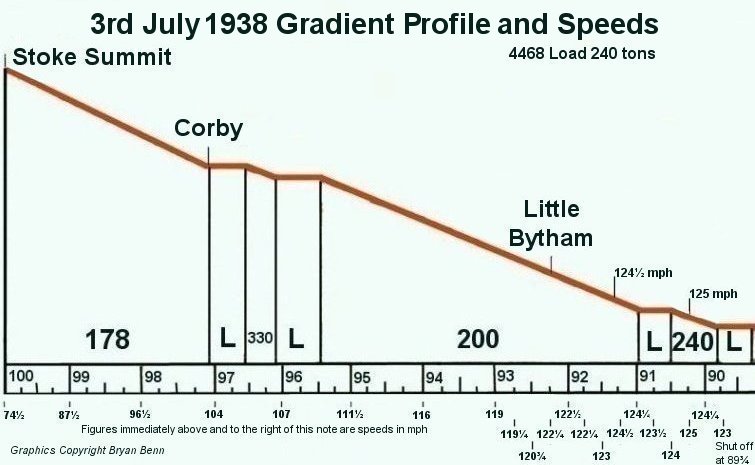 The gradient profile has been reproduced as faithfully as possible but is subject to the limitations of the screen display and the software used.
The gradient profile has been reproduced as faithfully as possible but is subject to the limitations of the screen display and the software used.
|
|
Gradient Profile
The gradient profile and speeds are by reference to C J Allen's "Locomotive Practice and Performance in the 20th Century", and other sources. Mallard had a long and at times, steep, downhill route. Three miles at 1/178, just over a mile and a half at Level or down at 1/330, then more than four and a half miles straight off at 1/200 gave an excellent platform for the high speed attempt. Despite Mallard's slightly heavier train weight these grades still provided an enormous advantage over 05 002. Speed details The speed details in CJ Allen's book are from the official LNER log, originating from dynamometer car data. It is hoped a copy or the original can be examined to help explain anomalies outlined below. The data shows a constant speed increase before the 1/200, where the speeds become erratic with a maximum of 122.5 mph before speed falls slightly, and then rises to 124.5 mph, before a fall to 124.25 mph while still on the 1/200. These fluctuations are a surprise as the loco was on full throttle and 40% cut off all the way down Stoke Bank to near mp 89¾ , except for the 1½ miles to MP 93 when 45% was used. No reason has been identified for these fluctuations. The loco then slows over the first part of the short level stretch but accelerates again onto the 1/240 where there is an astounding acceleration from 124 mph to 126 mph, (if that is a credible maximum), in around ¼ mile. At this speed an enormous, and in these circumstances a totally impossible increase in horsepower would be needed for even a 1 mph increase in speed, let alone a 2 mph increase. Detailed horsepower calculations from a respected analyst have also shown that if the speed fluctuations are ignored and a straight speed increase assumed all the way to just before steam was shut off, a maximum of 125 mph was possible at milepost 90. The dynamometer trace shows 124 ¼ mph at that point. But there were significant speed fluctuations on the dynamometer car trace which I find difficult to ignore completely: that trace is after all the sole source of data for Mallard's run. I would also have thought that bearing in mind the enormous extra horsepower needed to accelerate fast on the short 1/240, that the maximum speed could well have occurred at the bottom of the long 1/200. The claimed 126 mph is over 60 yards, (1 second), within a 305 yard section where speed is said to have reached 125 mph. CJ Allen's log of this run shows a 125 mph maximum at mp 90¼, referring to the 126 mph in a footnote. A unique way for a steam loco log to be presented. If Mallard had reached 126 mph he would surely have put that speed in the detailed log. It is also said that Sir Nigel Gresley who designed the A4 pacifics only accepted 125 mph as the maximum. For these reasons and for the points raised in the preceeding paragraph I view 125 mph as the highest possible speed for Mallard on 3rd July 1938. Horspower outputs The dynamometer car drawbar horsepower details will be sought to see what unexpected fluctuations occured on the descent. Scrutiny will be needed at the point where the apparent sudden acceleration from 124 mph to the possible 125 mph maximum and the claimed 126 mph occurred on the easier 1/240 downgrade. Where such additional horsepower came from will be of great interest considering the loco must surely have been working at it's maximum power when it reached and, according to the published dynamometer car data, could not sustain 124.5 mph on the 1/200 downgrade a few seconds earlier. Time and Speed details It is an easy computer task to use the detailed dynamometer car speeds in the log, convert them to exact times and produce a time for the overall distance covered. If the dynamometer car speeds were accurate those times should equal the times being recorded by the dynamometer car chronograpth. I have done those calculations, (2 different methods), and over the 3 miles from MP 93 to MP 90 times from the dynamometer car speeds are ½ second faster than those in CJ Allen's published log, which are shown to the nearest ¼ second and are believed to be from the dynamometer car chronograph. Over that 3 mile distance this translates to an average over reading by the dynamometer car speed trace of 0.8 mph. I.e the published speeds for Mallard's run could be up to 0.8 mph overstated. This apparent error may be caused by the way in which the times have been extracted from the dynamometer car trace, and therefore have no significance. Further investigation will be made. Summary of Notes A maximum of 125 mph can be calculated just before steam was shut off by reference to horsepower outputs if the fluctuating data recorded by the dynamometer car on 3rd July 1938 is converted to a straight line acceleration. But staying to some extent with the actual dynamometer car speeds including the fluctuations, logic seems to indicate that Mallard's undoubted superbly fast run down Stoke Bank should have reached it's maximum of close to 125 mph on the very last few yards of the 1/200 downgrade. Not just afterwards on a less steep grade where a sudden acceleration to even 125 mph would have needed a dramatic increase in horsepower from a loco already working flat out with unchanged control settings. Further investigation into the possible discrepancy between dynamometer car speeds and times is still needed, although there may be a simple explanation here that has no impact on the likely maximum speed. From all the above I currently feel Mallard's maximum speed was close to, but no more than 125 mph. A speed seemingly supported by CJ Allen and Sir Nigel Gresley. |
|
05 002 v Mallard: Additional Factors and Conclusions The dynamometer cars For reasons already explained I have eliminated the 126 mph maximum from this discussion. But why was this speed ever mentioned: apparently only some years after July 1938? A "glitch" in the dynamometer car trace that apparently recorded 126 mph for 1 second, (just 60 yards)? A time and distance that would be scoffed at as a basis for a maximum speed by many of today's train timers. Did it arise from a subsequent interview with the driver of the A4 who gave the 126 mph as the speed he estimated from some source or other? Or was a "political" decison taking within railway circles after World War 2 to raise the speed to 126 mph to ensure there was no doubt an English loco held the world steam speed record, rather than a German one? Or perhaps there was a problem with the dynamometer speed recording mechanisms? Disturbing evidence emerged in a 2003 STEAM RAILWAY magazine article about Flying Scotsman's claimed 100 mph in 1934. CJ Allen clocked 97.3 mph, but agreed a 98 mph maximum, (although the 100 mph max is mentioned in his book "Locomotive Practice and Performance in the Twentieth Century"). The dynamometer car trace reproduced in STEAM RAILWAY also shows an unatural "glitch" at the "100 mph" maximum speed. Was this caused by a "jolt" to the recording pen or some other fault? And did this happen with other high speed dynamometer recorded runs in the UK? It certainly puts into sharp focus the different maximums of 125 and 126 mph claimed for Mallard. Or was the 32 year old dynamometer car just not recording the speeds in a consistent and accurate fashion? Such a fault could explain why the speed trace recorded a maximum other than at the "logical" spot at the end of the 1/200 grade, but on the very short stretch of 1/240 that followed after a short levelling of the grade. That gives Mallard a speed close to, but certainly no higher than 125 mph. Horsepower calculations ignoring the recorded speed fluctuations do indicate a maximum of 125 mph could have been possible immediately before steam was shut off, a point where the speed trace actually shows 124 ¼ mph. Dynamometer car problems do not appear to be an issue with 05 002's run. My temporary large scale copy of that speed trace shows a straight line through the 200 km/h mark on the same gradient to a maximum obviously higher than 200 km/h. A speed virtually the same as Mallard's most likely maximum: two speeds that I would be very surprised if correctly working early 20th century technology in those dynamometer cars could sensibly be expected to seperate. My first conclusion therefore is that both locos probably reached a speed close to, but no higher than 125 mph. Criteria for a world record attempt?. Mallard's work on that run started a little North of Grantham, and ended at Peterborough around 40 miles later when the loco was failed with an overheated middle big end bearing. For the fastest section of it's run it had the benefit of a very long, and at times steep, down hill grade. 05 002 ran the 165.6 miles from Hamburg to Berlin at an average speed of over 81.1 mph, inclusive of a two and a half minute stop at Wittenberge. If the stop had been momentary the average would have been very close to 83 mph. The loco exceeded 110 mph before the Wittenberge stop. And reached it's record maximum speed after the stop, before continuing still at fast speeds onto Berlin-Spandau. All on a route without really significant gradients. Near level track and the loco not failing could be considered vital criteria for any world speed record attempt. On the basis of these criteria I cannot possibly conclude that Mallard's effort equalled that of Germany's 05 002. The German loco probably ran as fast, if not faster than any steam locomotive ever did in Europe over such a long distance with just one very short stop mid way. The British pacific achieved it's maximum with enormous help at the critical time from long down hill grades, during a very short journey which was terminated when it failed. What other very high speed runs were achieved by these two streamlined steam locomotives? Only counting authenticated records from a dynamometer car, or proper timing logs by experienced and trusted train timers, there are no other 110 mph runs by Mallard. Just a story of one further very high speed run without authentication. 05 002 ran nine times over 110 mph, five times over 115 mph and twice over 120 mph, ( table ). A truly fast steam locomotive, not one that made just one fast run, excellent as Mallard's effort was. I can find no better way of describing 05 002's overall high speed achievements than as above:- "I cannot possibly conclude that Mallard's effort equalled that of Germany's 05 002." |
| 05 002 v Mallard concluded |
|
Summarised Conclusions: 05 002 v Mallard 4468 Mallard and 05 002 were two fast, powerful steam locos in classes designed for trains that set new standards of European speed. They effectively, if maybe unintentionally, came head to head in the pre war years in the quest for outright maximum speed way above that needed for normal trains. In that quest both ran at speeds not seen with steam in Europe before or since, and possibly speeds not seen anywhere else. Bear those words in mind when reading my summarised conclusions as to which of these two fine steam locomotives should hold the title, "The World's fastest Steam Locomotive". Conclusions I consider identifies the World's Fastest Steam Locomotive on the basis of a single fastest run. 1. Both 05 002 and Mallard achieved a speed close to, but probably no higher than 125 mph. 2. 05 002 reached it's maximum speed without the loco failing, without the significant assistance of a downhill grade and in the course of long and very fast journey. The first two of which criteria could well be considered essential for any record attempt for most forms of transport. Mallard reached it's maximum speed without meeting any of the three criteria identified for 05 002. A conclusion I consider identifies the World's Fastest Steam Locomotive on the basis of it's wider performance. 3. Germany's maroon streamlined 05 002 also achieved a significant number of other very high speeds. All on level or near level grades, some over long journeys. These were unique achievements in Europe, untouched even by Mallard |
|
The combination of points 1 to 3 above lead me to conclude 05 002 deserves the title of the "World's Fastest Steam Locomotive" both from the sharp focus of the single fastest run by a steam locomotive, (1 & 2), and in the wider sense taking account of all very fast performances, (1 to 3).
The above conclusion is on the basis that my continuing investigations into high speed steam in the USA do not produce authentic evidence that takes the title away from 05 002. |
|
| ||
|
| ||
| Milwaukee Road
Four oil fired, two cylinder A class Atlantics, (4-4-2) were built in 1935-37 by Alco for the Milwaukee Railroad in the USA, (right). Below is one of Milwaukee's six coal fired F7 Hudsons, (Baltic, 4-6-4), built soon afterwards. In an era that lasted just 16 years these 10 locos set unsurpassed records for fast steam hauled passenger trains, achieving world wide fame under their "Hiawatha" name running between Chicago to St Paul-Minneapolis. Both types of loco came very close, if not equal to the fastest steam loco speeds of 125 mph set in Europe. The photo of A class number 3 on the afternoon Hiawatha is possibly a staged photo, but is at a location where that train did reach around 100 mph. A few weeks earlier, renowned locomotive performance recorder, Gerard Vuillet had indeed recorded 100 mph on this train near to here. Top:Atlantic no. 3 on the afternoon Hiawatha passes Oconomowoc, Wis., on 5/8/37. Photo: Otto Perry, Denver Library Collection, (OP-5141). License for display issued |
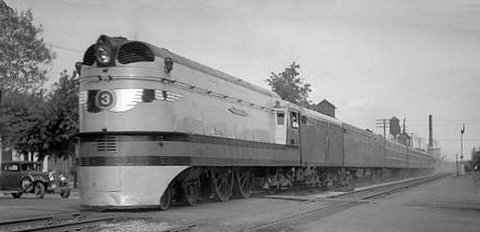
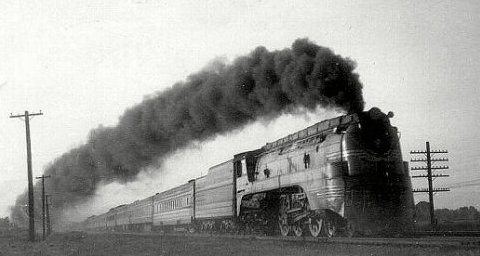
Above F7 no. 101 storms along near Milkwaukee on the afternoon Hiawatha, 31/5/40 Photo: By Arthur Johnson from the Stuart Kurth collection via the Don Ross web site, with thanks to Don and to Stuart's daughter. |
|
The A class Atlantics and F7 Hudsons were not Milwaukee's first fast locos. Their F6 Hudson No. 6402, was a contender for the "First Steam Locomotive to Reach 100 mph"; a subject covered on a different part of this site. And were one of Milwaukee's A class Atlantics or F7 Hudsons contenders for an even greater prize in the history of steam: the title of the world's fastest steam locomotive? Pushing aside Germany's 05 002 from that title earned on May 11th 1936, and discussed above. These two locos classes certainly set world records. For a time they operated the world's fastest steam hauled train schedule: the 78.3 miles from Sparta to Portage in 58 minutes, a start to stop average speed of 81 mph. And undoubtedly they would have also run more miles at 100 mph and above than any other steam locomotive in the world. Whether on a single journey where one timing log for an F7 saw 47.8 miles covered at an average pass to pass speed of 104.9 mph, (605 imp. ton train), and another, (695 imp. tons), covering 62 miles at an average of 100.5 mph. Or taking the number of miles at 100 mph or more for each loco, and for the number of miles at or above 100 mph for each of the two classes of locomotive. All unchallengable world records. But did one of them challenge 05 002's highest speed record? One significant difficulty in researching the Milwaukee Road streamlined locos is that few detailed records seem to have survived from that golden era of fast steam running, some of which are quoted above. But these are just sufficient to reach a reasonable conclusion about the capabilities and possible achievements of the ten locos that hauled the "Hiawathas" over the near 400 miles between Chicago and St Paul-Minneapolis. Thankfully a limited number of documents were seen and used by such masters of steam locomotive performance reporting as Cecil J Allen, John F Clay, Brian Reed, Baron Gerard Vuillet and others. All experts who would not accept and report any documentation of steam locomotive performance without being certain they were reporting factual information. So considerable reliance can be placed upon what these experts have written. This section will concentrate on the two Milwaukee streamlined classes as the only realistic USA challengers to the Europe claimed 125 mph World Speed Record for Steam. There have been other USA claims for higher speeds with steam, but none stand up to even the most cursory examination. These will be briefly covered in a later posting to this web site. Back to the Mikwaukee Road Hiawatha locos, and firstly a close up look at both designs and a brief tabulation of their key features. And then a look at what is known about the very high speed exploits of both types of "Hiawatha" steam locomotives. |
| Milwaukee A Class Atlantics | |
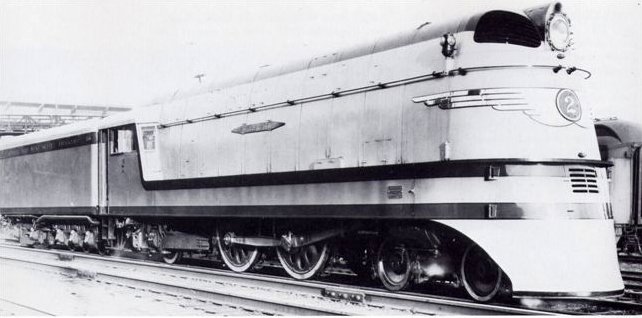
| |
| The Milwaukee Rail Road A Class Atlantics Photo: ALCO circa 1935 via the Helmut Dahlhaus collection | ||||
| Built | ALCO from 1935-37 | Total weight incl tender | 210 imp. tons | |
| Number Built | 4 locos nos 1 to 4 | Fuel | Oil fired | |
| Withdrawn, (all scrapped) | 1949 to 1951 | Fire grate area | 69 sq feet | |
| Cylinders | 2 sized 19" x 28" | Max ihp @ 100 mph | 3,000 | |
| Driving Wheels | 84" diameter | Cruising/ max speed | approx 100 / 120 mph | |
| Boiler pressure | 300 psi | |||
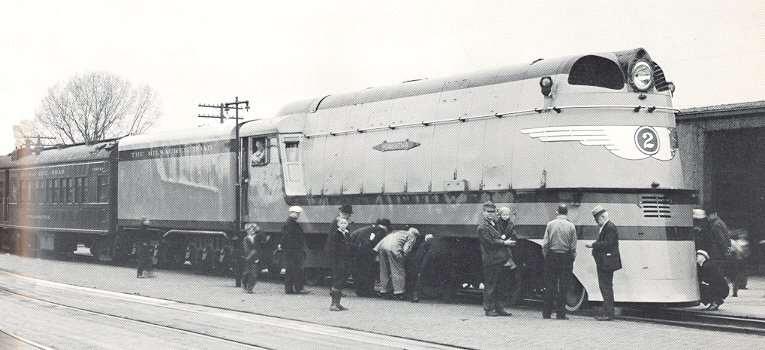 Milwaukee Road A class Atlantic No. 2 soon after arrival at New Lisbon on 15th May 1935
Milwaukee Road A class Atlantic No. 2 soon after arrival at New Lisbon on 15th May 1935
Photo by Milwaukee Road, from "The Hiawatha Story" by Jim Scribbings, copyright 1970, Kalmbach Publishing Co. Used with permission. |
| The photo of Milwaukee Road A class Atlantic No. 2 was taken on 15th May 1935 at New Lisbon, after it had hauled a 6 car test train from Milwaukee. Note the dynamometer car immediately behind the loco. The loco had been delivered to the Milwaukee Road at Chicago only a few days earlier on May 8th 1935, following No. 1 by just three days. On May 8th No.1 is reported to have taken a test train of around 450 tons, (Imperial), up to 90 mph. An excellent performance for a new loco, but not one planned to test the loco's design criteria of being able to cruise at 100 mph, with a maximum of 120 mph. |
|
Much better was to follow that 90 mph run by No.1 On 15th May 1935, with a train that would have weighed not much under 300 tons , (Imperial), and with driver Ed Donahue at the regulator No. 2 ran a reported 14 miles at 112.5 mph on a Hiawatha test run between Milwaukee and New Lisbon, Wis. The detailed records of this run have not yet been located, neither are the methods used by the dynamometer car to record the speed known. But at present the fact that the dynamometer car was on this run is an indication that the maximum speed quoted could very well have been correct.
The date is also very significant. The first authentic speed over 110 mph in the UK, (LNER A4 "Silver Link"), was not to happen until more than five months later. German 05 002 was not yet in service, it's first very high speed, (119 mph), not being recorded until 7th June 1935. Records for any faster runs by 05 001, which was in service before 15th May 1935 have not yet been found. So if the recording methods used in the dynamometer car were correct, then that 15th May 1935 run by Milwaukee A class No.2 was most likely the fastest authentic speed reached by a steam locomotive at that time anywhere in the world. |
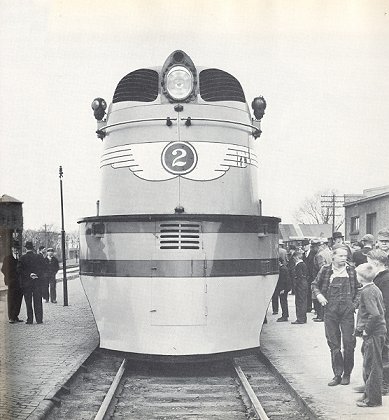 Another view of No. 2 at New Lisbon on 15th May 1935
Another view of No. 2 at New Lisbon on 15th May 1935
Photo by Milwaukee Road, from "The Hiawatha Story" by Jim Scribbings, copyright 1970, Kalmbach Publishing Co. Used with permission. |
|
My research into the very high speed exploits of these superb steam locomotives continued for a while, but nothing was unearthed that changed anything on this web page. But, before concluding my findings concerning the Milkwaukee Road, which focus on their F7 4-8-4 locos, a brief mention of high speed claims for USA steam locos, and my reasoning for giivng such weight to whjat is on this page about Milwaukee Road locomotives. There are many stories of very high speed steam loco exploits in the USA. The vast majority do not stand up to even the most cursory examination. Two well publicised examples are the claimed 127 mph in June 1907 for an E2 Atlantic working between New York and Chicago. And the even more well known claim of 141 mph for PRR's S1 "duplex". Neither of these claims has any supporting data timings available and that is no surprise as both would have needed an enormous increase in their maximum horsepowers to have got anywhere near the claimed speeds: for the E2 more than a 300% increase and not an enormous amount less than that for the S1! So, do the very high speed claims for the Milwaukee Road A class Atlantics fall into this, "wildy exaggerated" category. No, they certainly do not, but as in so many cases in the USA very few records remain. Respected loco perfomance expert, the late Brian Reed writes in his Loco Profile 26, "..in the early years of the Hiawathas speeds of 105 -110 mph abounded, and even 120 mph was attained by Atlantics.......on slight downhill grades 105 -110 mph was attained and maintained, and even 112 to 120 mph was reached on occasions by the Atlantics with six or seven cars...". I do not feel Brian would have written those words if he had not seen some evidence. Indeed in that same Profile is reproduced part of a loco speedroll from Atlantic no.2 on a Westbound run on May 21st 1936, on the last part of the journey into Milwaukee. This shows that a speed of between 100 and 110 mph was sustained for 10 miles on undulating track. The 110 mph mark being reached 3 times. But no supporting data remains to verify the 120 mph by these superb steam locomotives, even though there is no doubt that on the downhill grades they could have reached that speed: Brian Reed did after all report that if 114 mph had been reached on such a downhill grade an Atlantic hauling six of seven cars could maintain that speed on level track: such was their power output and fast running ability. One thing that recent research has uncovered is a comment by John F Clay in a November 1976 Railway World article. He refers, presumably, to the 15th May 1935 test run when he states "...there is a dynamometer car record of 112.5 mph...". That does at least re-inforce 112.5 mph as the fastest substantiated speed for an A class Atlantic. Tantalislingly John goes on to say ".....and less well authenticated claims of over 120 mph on the speedometer tapes during acceptance trials........" And on that tantalising note my research on the very high speeds of the A class Atlantics must come to an inconclusive end. At least until any firmer evidence is found. So, it's now back to high speed running on the Milwaukee Road, by briefly introducing their F7 4-8-4 locomotives. |
| Milwaukee Road F7 Hudson (4-8-4) locomotives | |
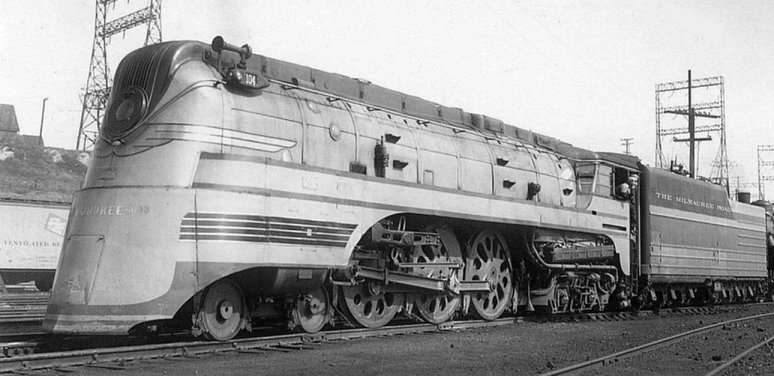
| |
| The Milwaukee Rail Road F7 Hudsons Photo No. 104 at Milwaukee on 22/9/40. By Edwin Wilson via the Don Ross Collection | ||||
| Built | ALCO in 1938 | Total weight incl tender | 315 imp. tons | |
| Number Built | 6 locos nos 100 to 105 | Fuel | Coal, (mechanical stoker) | |
| Withdrawn, (all scrapped) | 1949 to 1951 | Fire grate area | 96.5 sq feet | |
| Cylinders | 2 sized 23.5" x 30" | Max i.hp @ 100 mph | Above 4,000 | |
| Driving Wheels | 84" diameter | Cruising/ max speed | Above 100 mph / Above 120 mph | |
| Boiler pressure | 300 psi | |||
|
At this point in my research, April 2005, I paused my research. And subsequent to that date, due to changes in the operation of the company that hosted my web page, I needed to remove the page from their server, prioe to me re-working it so it could be uploaded again. Before doing that, I started a very detailed study into Short-eared Owls in Britain. And now, in March 2021 I am in the final stages of preparing the publication of a book I have written on that species of owl. So this web page documents as far as my study of the Milwaukee Road streamlined steam locos and their claim to be contenders as the worlds' fastest steam locos. I hope to restart that study fairly soon, and also hope to come back here with more details. That could lead to conclusions on the F7 speed achievements and capabilities being posted here. Then I will add a section revealing my conclusion on which steam locomotive truly deserves the title of "The World's Fastest Steam Locomotive" If you can help me locate authentic speed records of these superb Milwaukee A class and F7 class steam locos please contact me In the meantime why not scroll down to read about what, early in the 21st Century, was the World's Fastest Operational Steam Locomotive, German 18 201. Bryan Benn, March 2021 |
18 201: The world's fastest steam locomotive that operated in the 21st Century
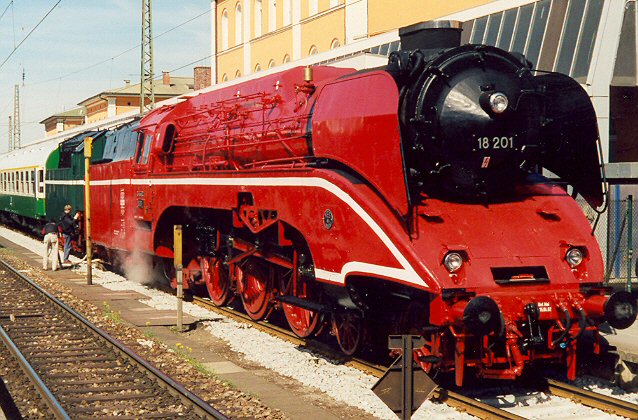
1st May 2002 saw 18 201 during the water stop at Passau, whilst hauling a Nürnberg to Wien Sonderzug |
| 18 201, continued
18 201 is a truly remarkable pacific type of steam locomotive. It was built as number 61 002 in 1939 by Henschel in Germany as a 4-6-6 streamlined tank locomotive: primarily to operate a high speed service from Berlin to Dresden, which was already being worked by two cylinder 4-6-4 tank 61 001. The train was known as the Henschel-Wegmann-Züge after Henschel-Wegmann who supplied the coaches. This service ran from July 1st 1936 until the outbreak of WW II as D53/54 and D57/58. 61 002 can only have operated this service for a very short period of time, and presumably did very little work before it emerged from a very major rebuild in Meiningen loco works as pacific number 18 201, later to become 02 0201-0. It's prime purpose from 1961 onwards was to test high speed coaches being built by the Comecom countries for export. It also operated some normal passenger services. Most of it's documented very high speed running has been on test after overhaul. There is some uncertainty over the exact maximum speed it has reached, there is mention of a 190 km/h test run, but it seems likely that the 182.4 km/h, 113 mph, achieved on 11th October 1972 is probably the fastest recorded. What is not in much doubt is that on 5th July 1995, when on test between Halle and Wittenberge it reached around 180 km/h as a light engine! And it most certainly was the first, (and currently the only), steam locomotive to haul a passenger train at over 100 mph in the 21st Century. The loco came back into service after overhaul in the Spring of 2002, sporting a superb red livery. Not all enthusiasts have welcomed this temporary colour scheme, and although it was planned to be back into it's more usual green colour by the Autumn of 2003 this has still not happened at the start of 2004. More details of this loco's history and achievements will be posted on my 'First Steam Locomotive To Reach 100 mph' page when I re-do that page and upload that to my web hosting company. But, for the time being, scroll down to see some photos taken by Jürgen-Ulrich Ebel which give some fairly convincing evidence of it's July 1995 180 km/h run! |
| These photos by the kind permission of Jürgen-Ulrich Ebel.
Jürgen is a railway author and journalist, as well as a dedicated steam enthusiast. He has authored and co-authored a number of EISENBAHN KURIER books. The occasion was a test of 18 201 after repairs to it's 7 foot 6 inch driving wheels. The loco was being driven light engine between Halle and Wittenberge by regular driver Klaus Bechstedt on 5th July 1995. Below the loco is building up speed as the speedometer needle hovers around the 160 km/h mark, circa 100 mph. To the right the needle is on the 180 km/h mark, circa 112 mph. 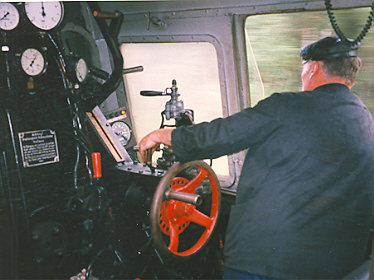 |
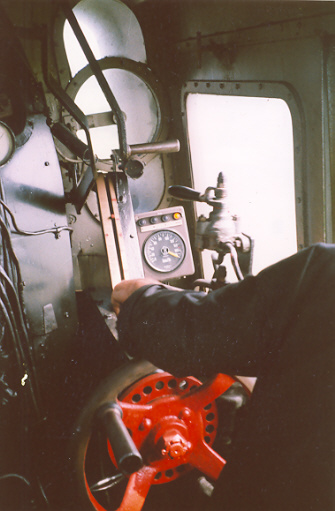 |
|
Can you help with this web page? I plan to resume my research into high speed steam locomotive running soon. It is a subject where many claims have been made for very high speed steam running, especially on Web Sites! I am using the Internet as a extremely valuable tool to unearth claims made that can subsequently be supported by documentary evidence from areas such as reputable authors/timers logs, locomotive test data, (ie from Dynamometer cars or Messwagen), and locomotive speed recording speedometer rolls. I am interested in instances where proper documentary evidence supports speed of around 110 mph and above, (approx 175 km/h and higher). I am especially interested in gaining access to locomotive speeedrolls from Milwaukee A class Atlantics and Milwaukee F7 Hudsons when working the very fast trains that operated under the general heading of "Hiawatha". I already have access to Brian Reed's Locomotive Profiles that includes these locomotives. If you know of evidence that supports high speed claims for steam locos then please E mail me. Please only supply details of high speed steam loco running where full documentary evidence as outlined above is available. This is purely a hobby web site so no payment can be made for any help provided, but I will list the names of those who help in the compilation of the details. The decision as to what detail I include rests only with myself. Thank You Grateful thanks to The Kalmbach Publishing Co., Helmut Dahlhaus, Jürgen-Ulirch Ebel, Doug Landau, Steve Palmano, Alan Rees, Don Ross, Torsten Sohns and David Veltom and anyone I have inadvertently missed for helping with this page. Bryan Benn, March 2021 |
|
|